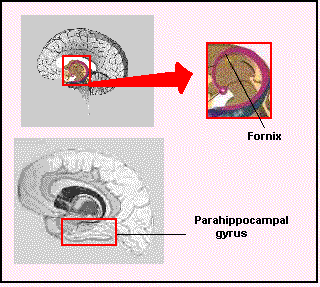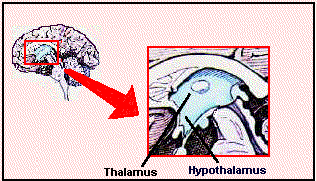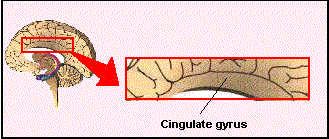

The Main Areas Involved with Emotions
It is important to stress that all these structures interconnect intensively and none of them is the sole responsible for any specific emotional state. However, some contribute more than others to this or that kind of emotion. We shall review now, one by one, the best known structures of the limbic system.
Amygdala and Hippocampus

| Amygdala
A little almond shaped structure, deep inside the antero-inferior region of the temporal lobe, connects with the hippocampus, the septal nuclei, the prefrontal area and the medial dorsal nucleus of the thalamus. These connections make it possible for the amigdala to play its important role on the mediation and control of major affective activities like friendship, love and affection, on the expression of mood and, mainly, on fear, rage and aggression The amygdala, being the center for identification of danger, is fundamental for self preservation. When triggered, it gives rise to fear and anxiety which lead the animal into a stage of alertness, getting ready to flight or fight. Experimental destruction of both amygdalas (there are two of them, one in each hemisphere) tames the animal, which becomes sexually non-discriminative, deprived of affection and indifferent to danger. The electrical stimulus of these structures elicits crises of violent aggressivity. Humans with marked lesions of the amygdala, loose the affective meaning of the perception of an outside information, like the sight of a well known person. The subject knows, exactly, who the person is, but is not capable to decide whether he likes or dislikes him (or her). |
Hippocampus
Is particularly involved with memory phenomena, specially with the formation of long-term memory (the one that, sometimes, lasts forever). When both hippocampi (right and left) are destroyed, nothing can be retained in the memory. The subject quickly forgets any recently received message. The intact hippocampus allows the animal to compare the conditions of a present threat with similar past experiences, thus enabling it to choose the best option, in order to guarantee its own survival. |
Fornix and Parahippocampal gyrus

| Both are important connecting pathways of the limbic system |
Thalamus and Hypothalamus

| Thalamus
Lesion or stimulation of the medial dorsal and anterior nuclei of the thalamus are associated with changes in emotional reactivity. However, the importance of these nuclei on the regulation of emotional behavior, is not due to the thalamus itself, but to the connections of these nuclei with other limbic system structures. The medial dorsal nucleus makes connections with cortical zones of the pre-frontal area and with the hypothalamus. The anterior nuclei connect with the mamillary bodies, and through them, via fornix, with the hippocampus and the cingulate gyrus, thus taking part in the Papez's circuit |
Hypothalamus
This structure has ample connections with the other prosencephalic areas and the mesencephalus. Lesions of the hypothalamic nuclei interfere with several vegetative functions and some of the so-called motivated behaviors, like thermal regulation, sexuality, combativeness, hunger and thirst. The hypothalamus is also believed to play a role in emotion. Specifically, its lateral parts seem to be involved with pleasure and rage, while the median part is like to be involved with aversion, displeasure and a tendency to uncontrollable and loud laughing. However, in general terms, the hypothalamus has more to do with the expression (symptomatic manifestations) of emotions than with the genesis of the affective states. When the physical symptoms of emotion appear, the threat they pose returns, via hypothalamus, to the limbic centers and, thence, to the pre-frontal nuclei, increasing anxiety. This negative feed-back mechanism can be so strong as to generate a situation of panic. As it will be seen later on, the knowledge of this phenomenon is very important, for clinical and therapeutic reasons. |
Cingulate gyrus

| It is located in the medial side of the brain between the cingulate sulcus and the corpus callosum (principal fiber bundle connecting the two cerebral hemispheres). There is still much to be learned about this gyrus, but it is already known that its frontal part coordinates smells and sights with pleasant memories of previous emotions. This region also participates in the emotional reaction to pain and in the regulation of aggressive behaviour. Wild animals, submitted to the ablation of the cingulate gyrus (cingulectomy), become totally tamed. The cutting of a single bundle of this gyrus (cingulotomy) reduces pre-existent depression and anxiety levels, by interrupting neural communication across the Papez's circuit. |
Brainstem

| The brainstem is the region responsible for the "emotional reactions", (indeed, they are just reflex answers) of inferior vertebrates, like reptiles and amphibians. The involved structures are the reticular formation, and the locus coeruleus, a concentrated mass of nor-epinephrine secreting neurons. It is important to stress that, even in humans, these primitive structures remain active, not only as alerting mechanisms, vital for survival, but in the maintenance of the sleep-awake cycle. |
Ventral Tegmental Area

| In the ventral tegmental area, located in the mesencephalic part of the brain stem, there is a compact group of dopamine-secreting neurons whose axons end in the nucleus accumbens (mesolimbic dopaminergic pathway). The spontaneous firing or the electrical stimulation of neurons belonging to that region produce pleasurable sensations, some of them similar to orgasm. Many people who, for a genetic error, have a reduction of D2 (dopamine) receptors in the accumbens nucleus, become, sooner or later, incapable to obtain gratification from the common pleasures of life. Thus, they seek atypical and noxious "pleasurable" alternatives, like alcoholism, cocaine addiction, impulsive gambling and compulsion for sweet foods. Certain brainstem structures, like the nuclei of the cranial nerves, stimulated by impulses coming from the cortex and the striatum (a subcortical formation), are responsible for the physiognomic : expressions of anger, joy, sadness, tenderness, etc. |
Septum

| The septal region lies anteriorly to the thalamus. Inside it, one finds the centers of orgasm (four for women and one for men). This area has been associated with different kinds of pleasant sensations, mainly those related to sexual experiences. |
Prefrontal area

| This area comprises the entire non-motor anterior region of the frontal lobe. It underwent a great deal of development during the evolution of mammals. It is specially large in man and in some species of dolphins. It does not belong to the traditional limbic circuit, but its intense bi-directional connections with thalamus, amygdala and other subcortical structures, account for the important role it plays in the genesis and, specially, in the expression of affective states. When the pre-frontal cortex suffers a lesion, the subject looses his sense of social responsibility as well as the capacity for concentration and abstraction. In some cases, although consciousness and some cognitive functions, like speech, remain intact, the subject can no longer solve problems, even the most elementary ones. When pre-frontal lobotomy was used for treatment of certain psychiatric disturbances, the patients entered into a stage of "affective buffer", no longer showing any sign of joy, sadness, hope or despair. In their words or attitudes, no traces of affection could be detected. |
3 of 4